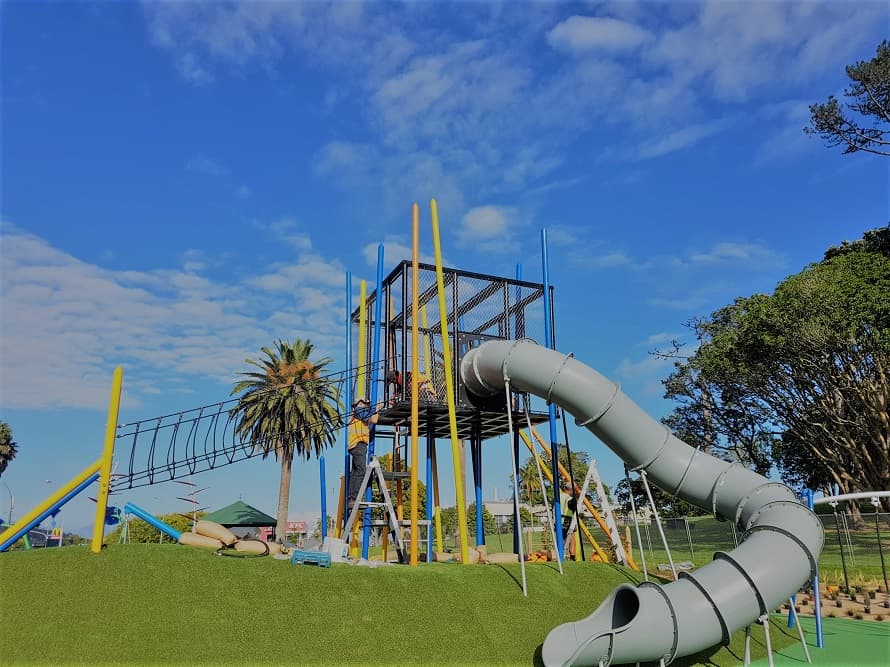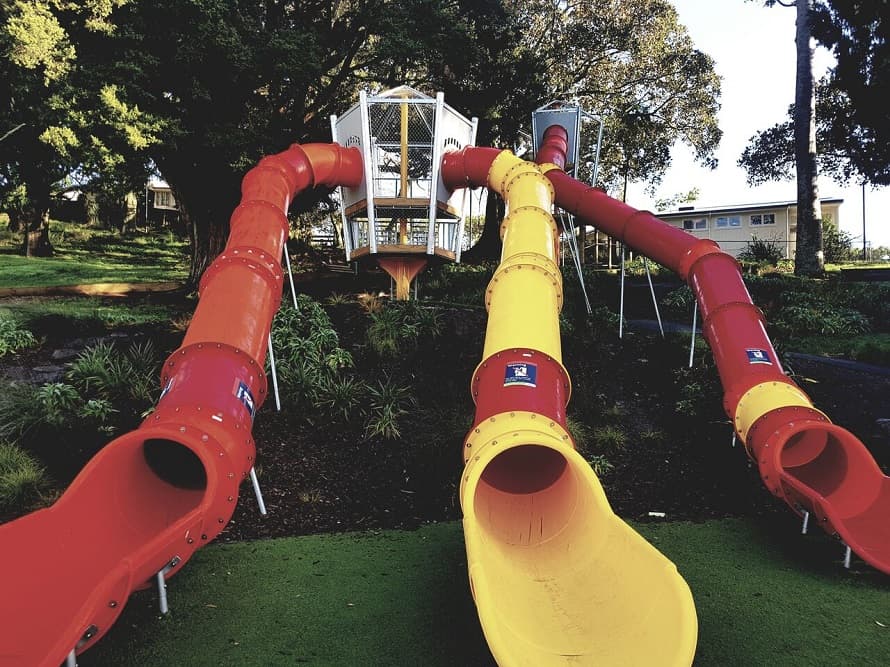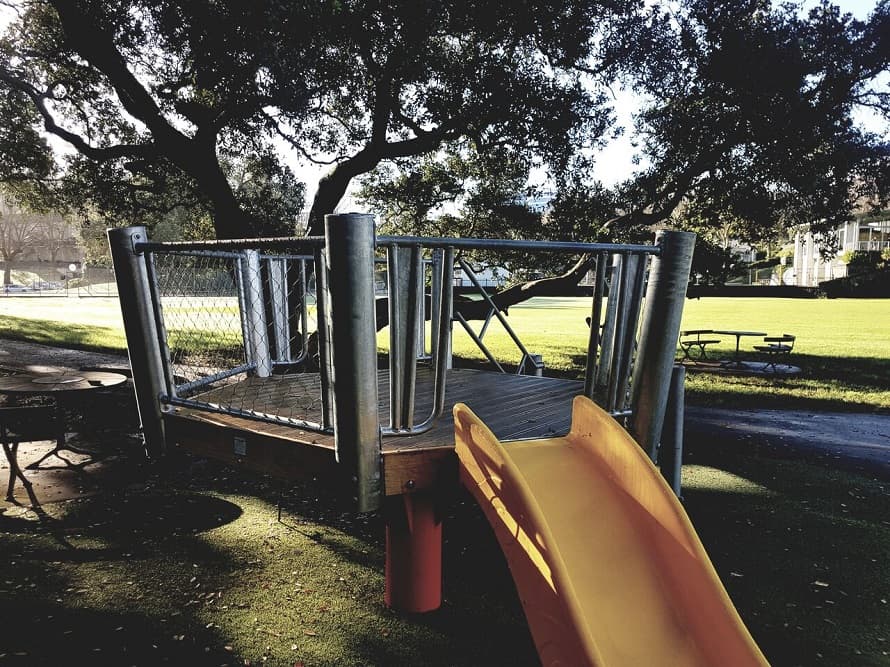Playground Equipment and Safety Fun Facts

Playgrounds have come a long way over the past 20 years. From the basic set-up that would typically include a seesaw, merry-go-round, a swing set and a slide, today’s modern playgrounds offer everything from climbing walls, to monkey bars to mazes and playhouses.
The improvements have undoubtedly helped to keep playgrounds relevant for today’s active kids. Playgrounds are competing with devices like mobile phones, tablets, and laptops, not to mention on-demand access to movies and TV shows that simply weren’t available to kids 20 years ago.
As well as improving the overall experience for kids, playground safety has also come a long way during this time. In the past, safety features on playground equipment were fairly limited and playground equipment was often placed on hard surfaces such as tarmac or concrete, leading to injuries for kids if they fell off the equipment. Not only have safety features on the actual equipment improved, but the whole landscape of the playground has changed, with a focus on safety as well as fun.
A brief history of playgrounds
Playgrounds were developed as far back as the 19th century when psychologists such as Friedrich Fröbel introduced playgrounds as a way of helping children develop a sense of fair play and manners, however, it was in Manchester, England, where the first purpose-built public-access playground was opened in 1859.
Until the widespread adoption of motor cars in the early 20th century, the streets were still the most common place for kids to play, however, the introduction of more vehicles on the roads led to a boom in the development of playgrounds in countries throughout the world.
This was the first step in considering kids’ safety when playing, however, the first playgrounds to open up had limited safety features on the equipment.
Improving safety standards
There is little doubt that safety standards in playgrounds all over the world have improved. From reducing the height of slides to changing the surfaces that playgrounds are built on, they are now much safer environments for kids to play in.
The safety features in playgrounds are typically developed as a way of preventing injuries for kids. There is, however, a fine balance that is required. Learning to assess risk is an important part of a child’s development, so it is also important that playground safety allows kids the independence to make those decisions on their own.
A lot of the safety improvements in playgrounds have come from a change in materials. Playground equipment was traditionally made from metal, and this brought with it a number of challenges from a safety perspective. The most obvious risk is the hardness of the surface. Some of the most common injuries in playgrounds are still to the arms, hands and fingers and hard metal surfaces cause issues when these limbs are bashed against them.

Today, modern playground equipment is constructed from moulded plastic, and this provides a solid surface but a safer environment for kids. Many adults today will also remember the pain of scooting down a metal slide in shorts and feeling the burn after the metal had sat in the hot sun all day.
As well as getting hot, metal also causes issues with coiled equipment such as seesaws or those animal cut-outs you sit on and ride. The coils have been replaced with plastic to decrease the likelihood of cuts and trapped fingers.
Another big change in playgrounds all around the world is the lowering of the height of certain pieces of equipment. Whilst slides are still found in most playgrounds, they are no longer as high as they used to be, and this has helped to reduce the number of accidents in playgrounds.
One final change has been the switch to more child-friendly materials as the base for playground equipment. From rubberised mats to wood chips to rubber mulch, the surfaces are much better at softening the impact for kids, whether they are falling or simply running around.
Why we need playgrounds
Playgrounds are such an important part of a child’s development. Whilst it might seem easier to hand your child their tablet or your phone or put on a movie, they miss out on so much if they don’t have the opportunity to “play out”. Here are some of the benefits:
- Improve their physical health – by nature, playgrounds encourage kids to run around and get active. Climbing, swinging, and jumping are all great exercises for improving their overall physical health.
- Improve motor skills – many pieces of equipment in a playground also help to improve motor skills including balance, strength, and coordination. Monkey bars contribute to improving hand and arm strength that can help with other aspects of their lives.
- Improved social skills – the playground is often one of the first places that friendships are formed. Kids quickly figure out how to interact with other kids and how to share space and this helps them develop other skills outside of the playground, preparing them for going to school.
- Collaborating and sharing – it’s amazing when you watch kids in a playground how quickly they learn to collaborate to achieve a task. Whether that’s giving another kid a leg up or offering a hand to pull them up onto a piece of equipment, kids learn how to work together in the playground.
- Gain independence – the playground will often be the first time that kids learn how to get on without the help of their parents. After gaining a little bit of confidence, kids will quickly head off on their own to explore and play.
- Problem-solving – a playground is a great place for kids to learn problem-solving skills. Working out how to get to the top of a piece of equipment, or how to get across an obstacle course is a great way to develop problem-solving skills at an early age.
Playground designers are having to work harder to compete with the digital world in which a lot of kids are growing up. They are having to get more creative in the way they design playground equipment and how pieces work together to keep kids stimulated and ensure they are still asking to go to the park rather than play a game on a digital device.
How SRS is helping to improve playground safety

We have been involved in several playground projects that utilise tensile mesh to ensure the safety of our Kiwi kids. With its view-friendly design, it means parents and caregivers can see what their children are up to at all times.
Play structures have been getting bigger and better over the past 20 years and with this has come additional safety concerns. Whilst slides may have gotten smaller over the past two decades, other equipment has gotten higher and the risk of a child falling has increased significantly.
We work with playground equipment companies to ensure the best possible levels of safety around their equipment. Our tensile mesh safety nets, with their view-friendly design, always allow for proper adult supervision, no matter what piece of equipment is installed.
The increased use of safety netting, as well as the improvements in playground surfaces, has helped to reduce the number of accidents in outdoor play areas significantly and SRS is glad to be playing its part.
Playground safety is just one of our architectural rigging solutions. Get in touch with the team today to find out more.
